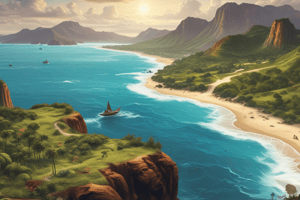Podcast
Questions and Answers
What are the main regions that comprise Oceania?
What are the main regions that comprise Oceania?
- Melanesia, Micronesia, Polynesia (correct)
- Antarctica, Arctic, South America
- North America, Europe, Asia
- Australia, Africa, Asia
Which major environmental challenge threatens low-lying islands in Oceania?
Which major environmental challenge threatens low-lying islands in Oceania?
- Rising sea levels due to global warming (correct)
- Urbanization
- Overfishing
- Deforestation
What is the dominant land use in Australia?
What is the dominant land use in Australia?
- Livestock grazing (correct)
- Urban development
- Forestry
- Crop cultivation
Which is NOT a characteristic trait of Pacific Island countries?
Which is NOT a characteristic trait of Pacific Island countries?
Which type of island is formed by volcanic eruptions?
Which type of island is formed by volcanic eruptions?
In terms of population distribution, what is the rural percentage of Oceania, excluding Australia and New Zealand?
In terms of population distribution, what is the rural percentage of Oceania, excluding Australia and New Zealand?
Which country experienced significant economic impact due to phosphate mining?
Which country experienced significant economic impact due to phosphate mining?
What is true regarding the cultural makeup of Australia and New Zealand?
What is true regarding the cultural makeup of Australia and New Zealand?
Flashcards
Oceania's major divisions
Oceania's major divisions
Australasia (Australia, New Zealand, and some islands), Melanesia, Micronesia, and Polynesia
Pacific Island population
Pacific Island population
Estimated at 40 million (2016), with Australia having the largest population.
Oceania's land use
Oceania's land use
Livestock grazing (especially in Australia), agriculture, forestry, mining, and urban development concentrated along coasts.
Island types in Oceania
Island types in Oceania
Signup and view all the flashcards
Oceania's cultures
Oceania's cultures
Signup and view all the flashcards
Oceania's economy
Oceania's economy
Signup and view all the flashcards
Oceania's environmental concern
Oceania's environmental concern
Signup and view all the flashcards
Australia-New Zealand relations
Australia-New Zealand relations
Signup and view all the flashcards
Study Notes
Oceania Overview
- Oceania encompasses one-third of Earth's surface, primarily within the Pacific Ocean.
- It comprises Australasia (Australia, New Zealand, and islands), Melanesia, Micronesia, and Polynesia.
- Pacific Island countries generally have small populations, economic challenges, and rely on foreign aid.
Major Divisions
- Melanesia ("Black Islands"), Micronesia ("Tiny Islands"), and Polynesia ("Many Islands").
- Diverse island types exist – continental, high, and low islands.
Population
- Oceania's population was approximately 40 million in 2016; Australia had the largest population (24 million).
- A substantial portion (76%) of the population in Oceania is rural, excluding Australia and New Zealand.
- Population growth rates vary across the region.
Climates and Biomes
- Climate spans a wide range from deserts to temperate areas across the region, mainly reflecting location and altitude.
- Biomes include savannas, steppes, deserts, and tropical rainforests representing varied environments.
Land Use
- Livestock grazing, particularly in Australia, is a significant land use.
- Agriculture, forestry, and mining are concentrated in resource-rich zones.
- Urban development mostly occurs along coastlines.
Cultural and Historical Geographies
- Australia and New Zealand have a majority European heritage with an indigenous population.
- Other regions have diverse ethnicities, including indigenous, Asian, and European influences.
- Rich linguistic and cultural diversity exists particularly in Papua New Guinea and Australia.
Economic Geography
- Regional industrial development is limited, characterized by poverty levels typical of developing nations (LDCs).
- The economy primarily revolves around exports of crops, fish, minerals, services, and growing sectors like IT, textiles, and tourism.
- Phosphate mining significantly impacted Nauru's economy previously.
Geopolitical Issues
- Most of Oceania's islands were formerly colonized; independence movements led to a majority of islands becoming independent nations.
- Islands remain of military and economic importance to various governing powers.
Environmental Future
- Rising sea levels due to global warming pose a critical threat to low-lying island nations.
- The Alliance of Small Island States addresses these challenges.
Australia and New Zealand Relations
- Australia and New Zealand share similarities in population, cultural heritage, and economic orientation.
- They are prosperous nations with strong ties to the UK; however, relations with the U.S. are also significant.
Indigenous People
- Indigenous Australians face challenges such as high infant mortality, unemployment, and low life expectancy.
- Land rights disputes continue, with efforts focused on documenting traditional land claims.
Exotic Species
- Introduced species in Australia have disrupted ecosystems, negatively impacting native species and environments.
Studying That Suits You
Use AI to generate personalized quizzes and flashcards to suit your learning preferences.



